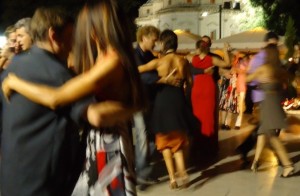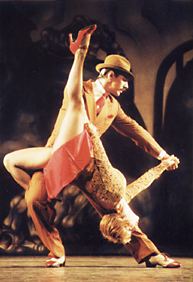What are figures good for?
I think first we need to define, what is a “figure” in Tango?
For me this is pretty obvious. A figure is a part of a choreography. For example a sequence of steps a dancer has memorized and can repeat on the dance floor.
That´s okay. I love dance performances with beautiful / interesting / smart / extraordinary choreographies.
Choreographies with their prefabricated figures are an indispensable help for professional dancers who need to perform on stage every evening maintaining a consistently high standard
A choreography gives dancers a framework to cling to.
Thus even if a professional dancer or a couple of dancers don´t have a good day, they can guarantee the audience of their tango show a performance on a high level.
On a busy dance floor however dancers who follow a choreography always have a crucial disadvantage (Unless all dancers would follow the same choreography).
There is always somebody standing in their way!

Important Tango lesson. Argentine Tango is a social dance. Always dance in harmony with all the other couples. You have to adapt to the flow of the dance permanently. Performing only prefabricated figures you don´t get very far. Photo: Wolfgang Sandt
You don´t dance Tango alone. Dancing in the „ronda“ the round of all the dancers on the dance floor you have to adapt to the others and cannot successfully use only choreographies and figures you have learned by heart.
Specially in Argentine Tango where the dance in the “Ronda”, the round of all the dancers steadily moves on, you don´t get far with a choreography, i. e. prefabricated figures.
This starts already with the first backward step of the so called “Passo Basico” the basic step, invented by Antonio Todaro, a legendary dancer and you might guess it – a choreographer)
Who has been to one of our Tango classes knows, that we usually don´t teach a basic step and figures. We put value on musicality, harmony with the partner, perception of your body, floorcraft and harmony with the other dancers.
In short, everything you need in real life on the dance floor.
So how can learning figures help a normal dancer, who is not performing in a Tango show?
Well, it can be fun to try something new, to discover new movements and to integrate them into your dance.
It is important though that you make them fit with the music and the situation on the dance floor and that they don´t disturb the harmony and flow of the dance.
Figures give you also the possibility to control your movements. To make them really work a lot of things must be right in place. Your posture, the contact with your partner, your position on the dance floor, they way you hold your arms…
But, – for all this you need a solid foundation and/or a Tango teacher who can explain exactly why a figure works, not simply which steps you need to memorize.
If you have this in mind, learning figures can be fun and helpful.
So if a figure doesn´t work, find out what is not working with your basics, and you have good chances to improve both.
Don´t forget one thing however: In Argentine Tango the figures come at last

